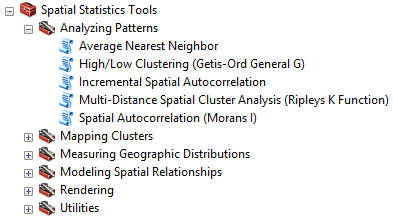The Analyzing Patterns toolset
The Analyzing Patterns toolset, found in the Spatial Statistics Tools toolbox and shown in the following screenshot, contains a set of tools that perform pattern analysis against a dataset. Each of these tools returns statistical information about the entire dataset. The output of these tools is not a map, but rather statistical information that helps determine if a dataset is clustered, dispersed, or has a random pattern.
To help interpret the results of these tools, this section will provide information about the null hypothesis, p-values, z-scores, and standard deviations.

Understanding the null hypothesis
All the pattern analysis tools that we examine in this chapter work on the premise that our features or the values associated with those features are randomly distributed. This is known as Complete Spatial Randomness (CSR). This is the null hypothesis used with all the ArcGIS spatial statistics tools.
The pattern analysis tools return z-scores and p-values...































































